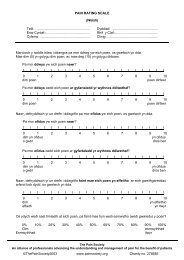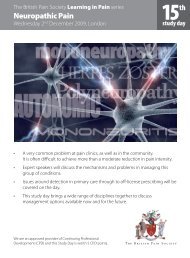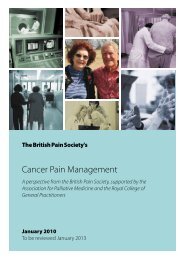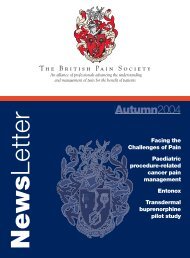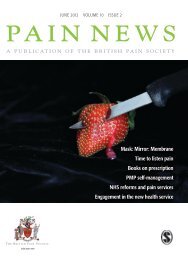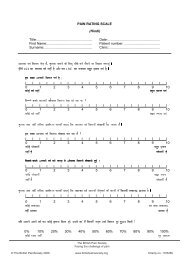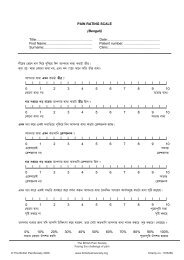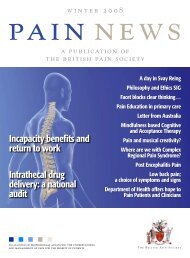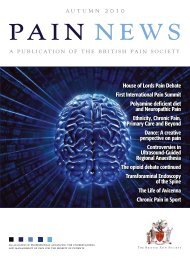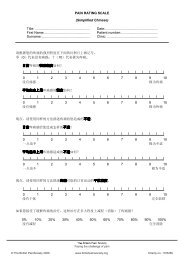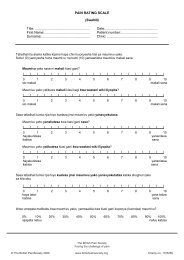Summer 2010 - The British Pain Society
Summer 2010 - The British Pain Society
Summer 2010 - The British Pain Society
You also want an ePaper? Increase the reach of your titles
YUMPU automatically turns print PDFs into web optimized ePapers that Google loves.
12<br />
5 8<br />
PAI N N E W S S U M M E R <strong>2010</strong><br />
iordan Mihaylov<br />
shyaM BalasuBraManian<br />
univErsity hosPitaLs covEntry and<br />
warwickshirE<br />
PAI N N E W S S U M M E R <strong>2010</strong><br />
PAI N N E W S S U M M E R <strong>2010</strong> 13<br />
PAI N N E W S S U M M E R <strong>2010</strong> 53<br />
Third Floor Churchill House<br />
35 Red Lion Square<br />
London WC1R 4SG United Kingdom<br />
Tel: +44 (0)20 7269 7840<br />
Fax: +44 (0)20 7831 0859<br />
Email info@britishpainsociety.org<br />
www.britishpainsociety.org<br />
Registered charity in England No. 1103260<br />
Registered charity in Scotland No. SC039583<br />
<strong>The</strong> opinions expressed in PAIN NEWS do not necessarily reflect those of the <strong>British</strong> <strong>Pain</strong> <strong>Society</strong> Council.<br />
contents<br />
PAI N N E W S S U M M E R <strong>2010</strong><br />
BPS Council<br />
Professor Richard Langford<br />
President<br />
Dr Joan B Hester<br />
Past President<br />
Dr William Campbell<br />
Honorary Secretary<br />
Dr Patricia Schofield<br />
Honorary Secretary Elect<br />
Dr John Goddard<br />
Honorary Treasurer<br />
Elected members of Council<br />
Dr Nick Allcock<br />
Dr Andrew Baranowski<br />
Dr Sam Eldabe<br />
Dr Austin Leach<br />
Dr Edward Lin<br />
Dr Mick Serpell<br />
Dr Thanthullu Vasu<br />
Dr Stephen Ward<br />
Ms Suzy Williams<br />
Co-opted members of Council<br />
Prof. Sam Ahmedzai<br />
Representative: Association for<br />
Palliative Medicine<br />
Dr Mike Basler<br />
Editor, <strong>Pain</strong> News<br />
Mr Neil Berry<br />
Representative: Psychology<br />
Dr Heather Cameron<br />
Representative: Physiotherapy <strong>Pain</strong><br />
Association<br />
PAIN NEWS is published quarterly. Circulation<br />
1800.<br />
For advertising enquiries contact<br />
Ms Rikke Susgaard-Vigon at<br />
newsletter@britishpainsociety.org<br />
<strong>The</strong> editor welcomes contributions including<br />
Dr Beverly Collett<br />
Representative: IASP<br />
Miss Felicia Cox<br />
Co-Editor, Reviews in <strong>Pain</strong><br />
Dr Suellen Walker<br />
Chair, Scientific Programme<br />
Committee (2011 ASM)<br />
Prof. Maria Fitzgerald<br />
Representative: Science<br />
Dr Roger Knaggs<br />
Representative: Pharmacy<br />
Ms Celia Manson<br />
Representative: Royal College of<br />
Nursing<br />
Dr Michael Platt<br />
Co-Editor, Reviews in <strong>Pain</strong><br />
Mrs Nia Taylor<br />
Chair, Patient Liaison Committee<br />
Secretariat<br />
Ms Jenny Nicholas<br />
Secretariat Manager<br />
Mr Ken Obbard<br />
Events & Membership Officer<br />
Ms Rikke Susgaard-Vigon<br />
Communications Officer<br />
letters, short clinical reports and news of interest<br />
to members including notice of meetings.<br />
next submission deadline :<br />
30th July <strong>2010</strong><br />
Material should be sent to:<br />
Dr Mike Basler<br />
PAIN NEWS Editor<br />
55 Crawford Road<br />
Houston<br />
Johnstone<br />
Renfrewshire<br />
Scotland<br />
PA67DA<br />
Tel 01505 382 035<br />
Email newsletter@britishpainsociety.org<br />
designed and printed by Yves Lebrec (bps@lebrec.com)<br />
cover illustration © Barry Ward, <strong>2010</strong><br />
regulars<br />
4 Editorial<br />
6 From the President<br />
8 From the Honorary Secretary<br />
55 New Members<br />
59 Letters to the Editor<br />
ASM <strong>2010</strong> Section<br />
12 ASM <strong>2010</strong> Section<br />
14 Citation for award of Honorary<br />
Membership <strong>British</strong> <strong>Pain</strong> <strong>Society</strong>:<br />
Dr Joan Hester<br />
15 Citation for award of Honorary<br />
Membership <strong>British</strong> <strong>Pain</strong> <strong>Society</strong>:<br />
Professor Troels Staehelin Jensen<br />
15 Poster Prize presentations, <strong>2010</strong> ASM<br />
16 Citation for award of Honorary<br />
Membership <strong>British</strong> <strong>Pain</strong> <strong>Society</strong>:<br />
Ms Heather Muncey<br />
17 A personal experience of the ASM<br />
17 <strong>British</strong> <strong>Pain</strong> <strong>Society</strong> ASM – Manchester<br />
<strong>2010</strong><br />
18 Reports from the SIG Chairs meeting in<br />
Manchester<br />
news<br />
20 <strong>British</strong> <strong>Pain</strong> <strong>Society</strong> (BPS) and National<br />
Institute for Health and Clinical Evidence<br />
(NICE) -Joint Statement<br />
22 Clinical Excellence Awards Update<br />
22 New Audit into the impact of migraine and<br />
headache in children and young people<br />
24 Creating a Special Interest Group<br />
25 Formation of New Special Interest Groups<br />
26 Update from Wales<br />
27 Napp Awards for Chronic <strong>Pain</strong><br />
Management<br />
28 New document on Over the Counter<br />
management of pain<br />
29 Economics and Utility of Diamorphine Use<br />
29 House of Commons debate into<br />
Musculoskeletal Conditions<br />
30 Obitutary for Dr J Edmund Charlton - 9th<br />
October 1942 - 3rd April <strong>2010</strong><br />
professional perspectives<br />
34 A painful truth?<br />
38 Opioids for Persistent <strong>Pain</strong>: a personal view<br />
39 End of Life Choices?<br />
41 Diamorphine Necessary or Not?<br />
45 Teaching your grandmother to suck eggs:<br />
the pain history (101)<br />
48 Ethics Special Interest Group Summaries<br />
52 Narcotic Use in the Creative Era of Jazz<br />
changing practice<br />
54 Does Vitamin C have a role in the<br />
prevention of Complex Regional <strong>Pain</strong><br />
Syndrome?<br />
56 A Personal Reflection on the <strong>British</strong> <strong>Pain</strong><br />
Management Programme <strong>Society</strong> (SIG)<br />
Conference 2009<br />
58 Monitoring and intravenous access<br />
for epidural injections in chronic pain<br />
management: survey of practice<br />
book review<br />
59 Oral feeding difficulties and dilemmas<br />
pain shortcuts<br />
60 Incidence and Root Cause Analysis of<br />
Wrong-site <strong>Pain</strong> Management Procedures<br />
60 Intravenous infusions for chronic pain - a<br />
systematic review<br />
61 Group cognitive behavioural treatment for<br />
low back pain in primary care<br />
61 I.V. Ketamine for C.R.P.S.<br />
the possession of narcotics. She<br />
pleaded guilty and was sentenced<br />
to Alderson Federal Prison Camp<br />
in West Virginia. Her New York City<br />
Cabaret card was evoked which<br />
prevented her from working in<br />
the clubs for the next 12 years.<br />
Holiday latterly deeply regretted<br />
her addiction. She is quoted as<br />
saying,<br />
“Dope (Heroin) never helped<br />
anybody sing better or play music<br />
better or do anything better.<br />
All dope can do for you is kill<br />
you- and kill you the long, slow,<br />
hard way”<br />
“If you think dope is for kicks and<br />
thrills you are out of your mind.<br />
<strong>The</strong>re are more kicks and thrills to<br />
be had in a good case of paralytic<br />
polio or by living in an iron lung”<br />
She was unable to kick the habit.<br />
Later in her career her voice began<br />
to deteriorate under the strain<br />
of smoking, heroin and alcohol<br />
abuse. On 31st May 1959, she was<br />
taken to metropolitan hospital.<br />
Police officers arrested her for<br />
possession of heroin and searched<br />
her room. She remained here until<br />
her death on July 17th 1959, aged<br />
44, from cirrhosis of the liver.<br />
Gilbert Millstein of the New York<br />
Times described her death in the<br />
1961 sleeve notes, “in the room<br />
from which a police guard had<br />
been removed- by court orderonly<br />
a few hours before her death,<br />
which, like her life was disorderly<br />
and pitiful. She had been strikingly<br />
beautiful, but she was wasted<br />
physically to a small, grotesque<br />
caricature of herself. <strong>The</strong> worms<br />
of every kind of excess- drugs<br />
were only one- had eaten her. “<br />
Miles Davis (1926-1991)<br />
Miles Davis was an infamous<br />
trumpeter, band leader and<br />
composer. Davis started using<br />
heroin around 1950. He became<br />
depressed after his relationship<br />
to French actress Juliette Greco<br />
ended. This combined with a lack<br />
of appreciation from the critics<br />
and the fact that many of his<br />
contemporaries were using drugs<br />
led Davis to start taking heroin.<br />
At first he snorted it and then<br />
went on to using it intravenously.<br />
Davis was from an affluent family<br />
and did not seem to have social<br />
problems like Parker and Holiday.<br />
In 1953 his drug addiction was<br />
affecting his performances. Heroin<br />
had also killed two of his close<br />
friends Navarro and Webster. He<br />
CHANGING PRACTICE<br />
Monitoring and<br />
intravenous access for<br />
epidural injections in<br />
chronic pain management:<br />
survey of practice<br />
Epidural injections are performed<br />
for pain secondary to nerve root<br />
irritation. <strong>The</strong> three common<br />
approaches for the epidural<br />
injections are lumbar, caudal and<br />
transforaminal routes. Although<br />
pain clinicians perform these<br />
procedures frequently, there<br />
is paucity of robust guidelines.<br />
We require evidence based<br />
information on the medications<br />
used, need for intravenous access<br />
and the minimum monitoring<br />
standards during and after the<br />
procedure. <strong>The</strong> Royal College<br />
of Anaesthetists and <strong>British</strong><br />
<strong>Pain</strong> <strong>Society</strong> have published<br />
recommendations in 2002<br />
regarding the minimum standards<br />
of monitoring required for the<br />
performance of epidurals via<br />
the lumbar and caudal routes if<br />
local anaesthetics are injected.<br />
This includes blood pressure and<br />
pulse oximetry during and blood<br />
pressure and heart rate after the<br />
procedure (1).<br />
We conducted a prospective<br />
survey of practice of members<br />
attending the Interventional<br />
<strong>Pain</strong> Medicine Special Interest<br />
Group meeting in Manchester,<br />
9th October 2009. Fifty two out<br />
of fifty eight clinicians completed<br />
the survey questionnaire, making<br />
it a 90% response rate; 46 were<br />
consultants, one was an associate<br />
specialist and five were trainees.<br />
Results<br />
<strong>The</strong>re was a wide variation<br />
with the amount and volume<br />
of medication injected. In the<br />
caudal and lumbar approach,<br />
the local anaesthetic injected<br />
ranged between three and twenty<br />
mls of 0.25% bupivacaine (or<br />
levobupivacaine). <strong>The</strong> volume was<br />
between one and four mls in the<br />
transforaminal approach. Two of<br />
the participants preferred lidocaine<br />
0.5% over bupivacaine for the<br />
lumbar and caudal approach.<br />
<strong>The</strong> status of intravenous access<br />
for these procedures and the<br />
monitoring used are presented in<br />
the tables 1-3.<br />
<strong>The</strong> results highlight that about<br />
one third of the epidural injections<br />
are done without intravenous<br />
access. It is debatable whether<br />
intravenous access is necessary if a<br />
small amount of local anaesthetic<br />
is injected into the epidural<br />
space (although the potential risk<br />
of intrathecal spread is always<br />
present). We noticed that many<br />
of the clinicians inject significant<br />
eventually managed to kick the<br />
habit after returning to his father’s<br />
house in St Louis. After this he<br />
would spend time in towns like<br />
Detroit where he knew heroin was<br />
difficult to obtain. Davis’s addiction<br />
to heroin is unique in that it only<br />
lasted 4-5yrs. Davis never returned<br />
to heroin but it is reported that in<br />
his latter career he was addicted to<br />
other drugs, mostly cocaine. He<br />
finally managed to kick his cocaine<br />
habit in 1979 after he rekindled<br />
his relationship with actress Cicely<br />
Tyson.<br />
Davis died age 65 in 1991 from a<br />
stroke and pneumonia.<br />
Conclusion<br />
Jazz musicians of this time had<br />
many reasons for turning to<br />
heroin. Whether they used it<br />
to escape from troubled social<br />
circumstances, to cope with a<br />
disapproving society, to provide<br />
them with a “high” or in the<br />
mistaken belief that it would<br />
increase their creativity, most<br />
deeply regretted their addiction.<br />
Tolson and Cuyjet summarized the<br />
lives of these addicted artists in<br />
their 2007 paper,” the untapped<br />
potential that was languished on<br />
drugs and alcohol by these artists<br />
shall never be fully revealed.”” <strong>The</strong><br />
reality is [that] for most jazz artists,<br />
amount of bupivacaine 0.25% (5 –<br />
20 ml) without intravenous access.<br />
<strong>The</strong> results also suggest that the<br />
level of monitoring was often<br />
better after the procedure rather<br />
than during the procedure. Whilst<br />
the post-procedure monitoring<br />
is more important to rule out<br />
any haemodynamic changes,<br />
monitoring during the procedure<br />
may equally be necessary<br />
to identify episodes such as<br />
vasovagal syncope. <strong>The</strong> purpose of<br />
the audit is to survey the practice<br />
rather than analyse the outcome<br />
of these procedures.<br />
Conclusion<br />
<strong>The</strong> practice guidelines from<br />
International Spine Intervention<br />
<strong>Society</strong> (2) recommends<br />
physiologic monitoring and<br />
intravenous access for all<br />
procedures in which needles are<br />
placed near the dural sac.<br />
Although epidural techniques for<br />
pain management have been in<br />
existence for several decades,<br />
practitioners learn the techniques<br />
and the practice in different<br />
ways. <strong>The</strong> performance is based<br />
on personal experience rather<br />
than on robust evidence. One<br />
of the widely raised concerns<br />
particularly during the creative<br />
period from 1940-1960, substance<br />
abuse did more harm than good,<br />
and rather than being the road to<br />
creative genius, it was the pathway<br />
to premature death.”<br />
REFERENCES<br />
Tolson,G.H. and Cuyjet M.J. (2007)<br />
jazz and substance abuse: Road<br />
to creative genius or pathway to<br />
premature death. International<br />
Journal of law and Psychiatry,<br />
30,530-538<br />
http://www.time.com/time/<br />
magazine/article/0,9171,826388,00.<br />
html<br />
http://everything2.com/title/<br />
Drugs+in+Jazz<br />
http://everything2.com/title/<br />
Heroin+and+jazz<br />
www.bps-research-digest.blogspot.<br />
com/2008/01/would-jazz-greatshave-been-so-great.htm<br />
en.wikipedia.org/wiki/<br />
Charlie_Parker<br />
en.wikipedia.org/wiki/<br />
Billie_Holiday<br />
en.wikipedia.org/wiki/Miles_Davis<br />
Table 1. Caudal approach<br />
Caudal During procedure After Procedure<br />
NO ECG 19 / 47 (40%) 6 / 47 (13%)<br />
NO NIBP 26 / 47 (55%) 6 / 47 (13%)<br />
NO SpO2 12 / 47 (25%) 8 / 47 (17%)<br />
No intravenous access 17 / 47 (36%)<br />
Table 2. Lumbar approach<br />
Lumbar During procedure After procedure<br />
NO ECG 18 / 45 (40%) 9 /45 (20%)<br />
NO NIBP 23 / 45 (51%) 7 / 45 (15%)<br />
NO SpO2 12 / 45 (27%) 10 / 45 (22%)<br />
No intravenous access 12 / 45 (27%)<br />
Table 3. Transforaminal approach<br />
Transforaminal During procedure After procedure<br />
NO ECG 14 / 37 (38%) 6 / 37 (16%)<br />
NO NIBP 22 / 37 (59%) 5 / 37 (13%)<br />
NO SpO2 9 / 37 (24%) 6 / 37 (16%)<br />
No intravenous access 11 / 37 (30%)<br />
and the discussion following the<br />
publication of the recent NICE<br />
low back pain guidelines was the<br />
heterogeneity of the interventional<br />
pain practice. Many of us agree<br />
that interventional treatment<br />
procedures form an important<br />
facet in pain management. Whilst<br />
there are several hurdles in<br />
bringing uniformity to the practice<br />
due to the multiple variables in<br />
the nature of the patients we deal<br />
with and the available resources,<br />
still efforts must be taken to<br />
standardise our practice as much<br />
as we can. To survive in a world<br />
of evidence based medicine,<br />
focus should be on establishing a<br />
guideline development group to<br />
bring consistency to our practice.<br />
REFERENCE<br />
1. http://www.britishpainsociety.<br />
org/epi_inj.pdf<br />
2. Spinal Diagnostic & Treatment<br />
Procedures 2004, International<br />
Spine Intervention <strong>Society</strong><br />
(ISBN 0-9744402-0-5)<br />
PAI N N E W S S U M M E R <strong>2010</strong> 3




